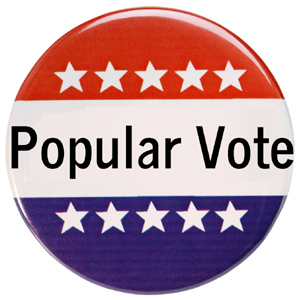The kneejerk thinking on the right goes something like this: We can’t support a national popular vote for president. If the presidency were decided by national popular vote, Hillary Clinton would be in the White House and big city Democrats would dominate every presidential election.
Assumptions like that are based on fear, not fact.
As noted professor and conservative author Dr. Gary Wolfram points out, “If you change the incentives to campaign, you change the way candidates campaign. And if you change the way they campaign, you change the outcome of the election.”
To surmise which candidate would have won the 2016 election under a national popular vote system is, of course, a matter of opinion. But it stands to reason that if the Trump and Clinton campaigns had approached the 2016 general election knowing they had to win the majority of the popular vote across all 50 states and the District of Columbia to gain the 270 electoral votes required to win the White House (the foundational principle of the National Popular Vote movement), they would have approached the campaign very differently.
At a minimum, both candidates would have been compelled to go after every voter in every state – red, blue, or purple – instead of focusing on micro-targeted precincts in key areas within 12 battleground states with a propensity to shift from one party to another every four years.
And clearly, they would have been forced to break the current pattern under which not a single one of the ten smallest states, or a single one of the most rural states, has hosted a major campaign event for a presidential candidate during the last 20 years.
As almost any thinking person would attest, ignoring millions of voters across 38 states is bad for democracy and bad for America. But that is exactly what’s happening.
Two-thirds of all major 2016 campaign events by the Trump and Clinton campaigns took place in just six battleground states – Florida, North Carolina, Pennsylvania, Ohio, Virginia, and Michigan. Despite their enormous populations, the reliably blue states of California and New York hosted just one major event between them. Same with the predictably red state of Texas – just one event.
As to the notion that a national popular vote would allow big city democrats to take over presidential elections – this is an irrational Republican fear that ignores one important fact: lightly populated rural areas and crowded urban cities (Top 100 Standard Metropolitan Statistical Areas) each contain one-sixth of America’s voting population. Simple mathematic principle dictates that 1/6 = 1/6. It always has and it always will. So big cities would be no more or less important than rural communities under a national popular vote for president.
Moreover, we know that big city Democrat voters do not always cancel out rural GOP voters in state-wide elections. Michigan, Pennsylvania, California, Minnesota, Wisconsin, and New York have all elected Republican governors despite those candidates being soundly defeated in big city precincts.
Now what about Texas? The Washington Examiner and others have reported that pollsters and analysts believe Donald Trump will have a difficult time winning this largest and most historically reliable red state in 2020. Both Republican U.S. Senators and state party leaders are reportedly urging the Republican National Committee (RNC) to treat Texas as a battleground state under the current winner-take-all system, where all of the state’s electoral votes go to the candidate who receives the majority of the popular vote across Texas.
Now, my fellow Republicans, ask yourselves this: If Texas is truly a battleground state, and if it flips its 38 electoral votes to the Democrats during the 2020 presidential election, what is the Republican path to the presidency under the current system?
The answer is – there isn’t one. There is no GOP path to the presidency without Texas and those 38 electoral votes.
And we have yet to discuss the increasing competitiveness of traditionally Republican states like Arizona, North Carolina, and Georgia – or the “blueification” of Colorado, Virginia, and Nevada. Or the fact that battleground states like Michigan (16 electoral votes) and Wisconsin (10 electoral votes) narrowly won by the President in 2016 could easily swing the other way next time.
Here’s the bottom line. It’s time for Republicans to stop jerking our knees and start engaging our brains. Long term, the current winner-take-all system gives Democrats the advantage in presidential elections. But America remains a right-of-center country, and by making every vote count, National Popular Vote could well be the saving grace of the Republican party.
Sixteen jurisdictions possessing a total of 196 electoral votes have already passed the National Popular Vote bill into law. Red states with 98 electoral votes should pass the measure in 2020, giving the National Popular Vote Interstate Compact more than the 270 electoral votes necessary to take effect. Under the new system, the compacting states would deliver 270 or more electoral votes to the winner of the national popular vote – who will always become the president.
Republicans can and will win on that playing field.
I am a Republican and I do not fear a national popular vote election.
Let’s have one. And let’s win it.

